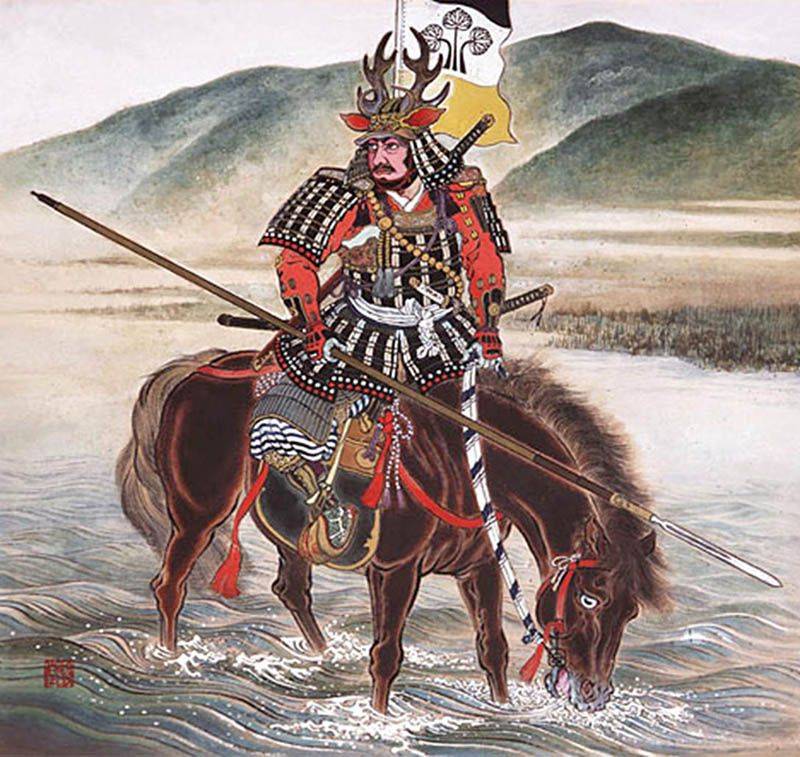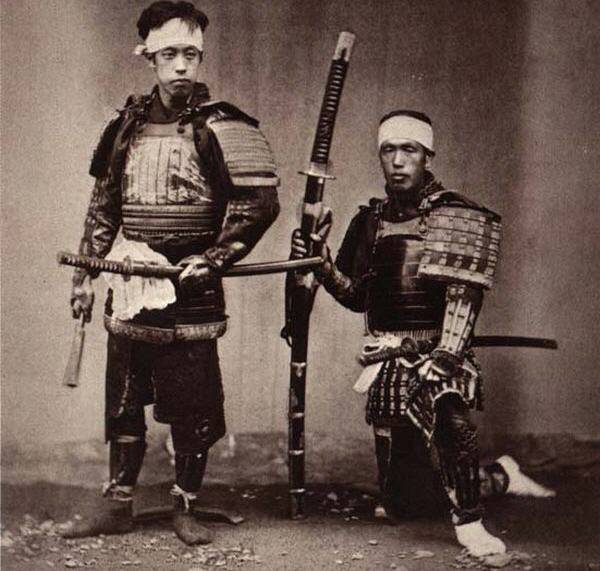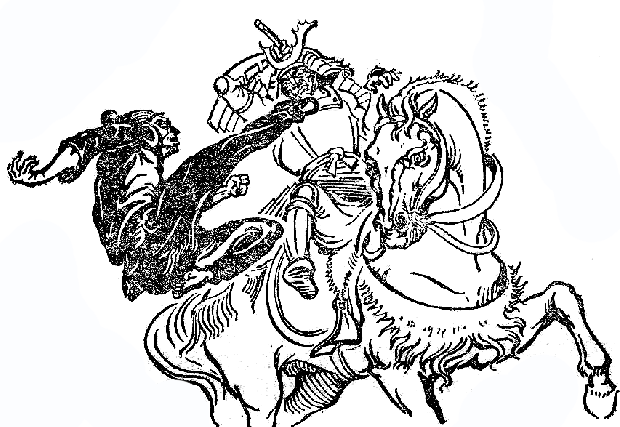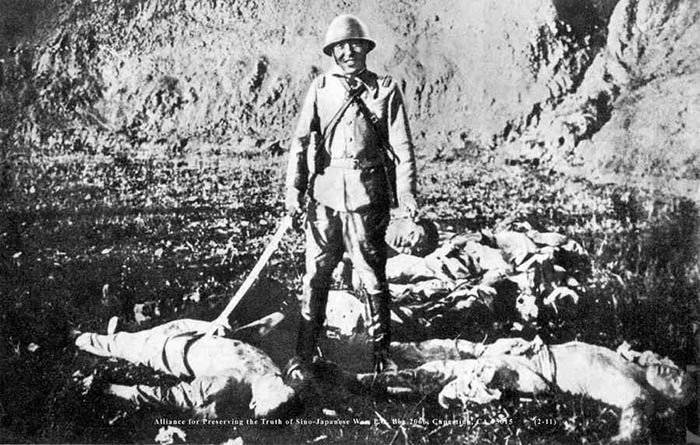Samurai and katanas: truth and fiction

Like martial arts, the first iron swords appeared in Japan due to cultural and economic ties with China. In the 2 of the 3rd century AD Chinese merchants brought the first batch of iron swords to Japan. Nowadays, archaeologists find in the mounds both Chinese specimens and later Japanese "imitations." By the eighth century. AD in Japan, its own iron production reached perfection, which led to a real revolution in cold arms. Now the Japanese warriors no longer needed to import imported Chinese products - local blacksmiths, having mastered the secrets of the Chinese and Korean masters, began to produce their own swords. If the Chinese blacksmiths - gunsmiths made swords from a single strip of iron, the Japanese forged steel and iron plates. Gradually, Japanese swords acquired a characteristic curved shape. According to tradition, the Kogarasu-Maru (Little Crow) sword is considered the first curved sword. He forged it in 703 AD. blacksmith Amakuni.
Further development of the Japanese cold arms occurred in parallel with the development of martial arts. The military component in the life of Japanese society has always played a huge role. This was facilitated by feudal fragmentation and constant conflicts between the princes and the samurai who served them. Subsequently, the pages of the Japanese stories were mythologized to a considerable degree, with the result that the West developed a rather superficial and idealistic perception of all Japanese - and cold arms, and samurai, and samurai codes of honor, and in general - the nature of relationships in Japanese society. Such a notion was promoted to a large extent by popular culture, which brought a vogue to the Japanese military theme among Europeans and Americans.
In Japanese culture, the sword played a huge role and was endowed with sacred value. There are several types of Japanese swords. The most famous, of course, is katana. A curved sword, more like a saber, the katana appeared around the 15th century and quickly turned into a “classic” samurai weapon. The katana was used in combination with a wakizashi - shorter sword. If the length of the blade of the katana was from 2 to 2,5 to shaku (60,6-75,7 cm), then wakizashi - from 1 to 2 to shaku (30,3-60,6 cm). Swords with a blade length less than 1 shaku were classified as tanto, i.e. daggers.
Katana and wakizashi made one blacksmith in the same style, since swords were considered a pair and were collectively called “dysho” - “long - short”. And if the swords were made by different masters, then they did not belong to dysс anymore. Because samurai swords had a special, sacred significance, the blacksmith profession was considered very honorable in Japan. Blacksmiths stood out among the rest of the artisans. As early as the 13th century, the emperor Go-Toba introduced the classification of blacksmiths according to their skill. The first class of blacksmiths had special privileges, because he had great skill. It was believed that the blades made by great masters have supernatural power. In fact, as in any feudal and estate society, belonging to the first class of masters was determined not only and even not so much by skill as by origin.
Many modern experts claim that the quality of Japanese swords was in fact far from perfect. At least they were no better than European, Middle Eastern or Indian swords. However, then spread the idea of the almost magical nature of the Japanese katana.

In many ways, the spread of the myths about the unprecedented quality and strength of Japanese weapons was contributed by the samurai themselves, especially in the period following the Meiji revolution. About the unprecedented military valor of the samurai went the most incredible stories, although they could well be pretty exaggerated. First, the entire history of the Japanese samurai’s combat path is replete with struggle with obviously weaker opponents. Only in the twentieth century, Japan faced with world powers - Russia, and then the United States and allies. Before this war, the Japanese state had a regional character. But is there any special prowess in defeating the Okinawan peasants or a weak army of fragmented Korea? The same Okinawan peasants resisted the Japanese conquerors very actively because they did not want to lose their independence (before the Japanese conquest, the islands of the Ryukyus archipelago were an independent kingdom with its own rich history and culture).
The history of the same karate dates back to the period of the struggle of the Okinawan population for its independence. I must say that the samurai dealt with the people of Okinawa very cruelly. Okinkaans were forbidden to have any weapons under the threat of death, after which, during the uprisings, the local population began to use a whole range of items of agricultural implements as weapons. It turned out very interesting - for example, the same tonfa. It was precisely for this reason that the improvement of methods of unarmed combat took place - the people of Okinawa wanted to confront the Japanese invaders by any means, including their bare hands and feet. On the other hand, it is clear that not so great masters of martial arts were the samurai armed to the teeth if they could be resisted by unarmed Okinawan residents.
Secondly, the stories about the unprecedented honor and loyalty of the samurai to their overlords, the daimyo, look somewhat exaggerated. In fact, when samurai were required, they could go on various actions, including even killing their overlord. Samurai troops could easily "change the owner" if the other prince was willing to pay them more salary. By the way, unlike the European tradition, treason was not considered something reprehensible. The samurai "ran" from one prince to another in whole detachments. In some cases, they were even divided into small detachments and offered their services to the opposing sides. By the way, the samurai “got it, too” not bad - from the Korean patriots, from the peasants of Okinawa, from their own Japanese peasants, who were raising powerful uprisings against feudal exploitation.
There was a special group of samurai - ronin, i.e. samurai who lost their master. As a rule, the ronin turned into wandering warriors, hiring bodyguards to noble and wealthy people, taking part in armed conflicts. But there were quite a few of those ronin who finally focused on criminal activity and turned into professional criminals "from the high road". This circumstance also speaks not in favor of the unprecedented nobility of the samurai class.
Thirdly, the idea of samurai’s rampant high literacy is also wrong. To begin with, the samurai for the most part were very young people, as professional warriors rarely lived to mature years. Learning literature, poetry, history, and philosophy for young samurai was simply problematic. After all, most of the time they devoted to honing military skills. No, of course, there were literate people among the medieval samurai, but the majority were either completely illiterate or professional soldiers who could barely write and read. There was nothing reprehensible and strange about this - just as many European knights were illiterate, not to mention professional landsknechts.
It is worth noting that the samurai martial arts had a purely utilitarian purpose. In contrast to the numerous styles of Chinese wushu, which almost all were formed and developed in Buddhist and Taoist monasteries and were not only martial arts, but also techniques of human psychophysiological improvement, in medieval Japan for a long time not enough attention was paid to hand-to-hand combat. It is quite understandable - why should samurai learn to fight without weapons if they were constantly with weapons? No, of course, there were some skills that could be passed on from senior to junior, but in general, the flowering of hand-to-hand combat began in Japan rather later than the story of “bujutsu” - the samurai martial arts proper. And the opponents of samurai — peasant rebels, wandering monks, criminal and political robbers, hired killers — made the greatest contribution to it. It was for them that possession of unarmed combat techniques or improvised objects was of much greater interest than for well-armed samurai.

Of course, it was not necessary to talk about some fantastic nobility of the samurai. They were distinguished by cruelty to the defeated opponents, and given that Japan is not a Christian country, this cruelty was not softened by religious ideas. If a samurai could commit ritual suicide, then killing another person, including the defenseless, was not difficult for him. Even in the twentieth century, the Japanese army was distinguished by extreme cruelty to enemies, which was reported by almost all opponents who had to fight with the Japanese troops.
What the Japanese occupation forces were doing in China and Korea is known to the whole world. Mass killings of civilians, executions and sadistic torture, rape and violent treatment of women in prostitutes - such actions remembered the Japanese troops in neighboring countries. Prisoners of war of the Allied forces who were in Japanese camps were subjected to the most severe torture. But after all, the backbone of the Japanese officer corps was made up of representatives of noble samurai surnames, who had noble origins and were proud of their heroic ancestors. It turns out that they also supported this behavior of their soldiers and did not consider him reprehensible.
Of course, what the samurai do not take away is the idea that honor is a more valuable category than life. Hence the samurai tendency to sacrifice. In addition, ritual suicides were fairly common in Japanese society and were based on the specific worldview of the samurai. It was more preferable for them to give up their lives in some situations than to preserve them, but to lose their honor. The host’s order to commit ritual suicide also played a major role. Most of the samurai could not afford to disobey such an order.

Harakiri or seppuka was seen as a worthy end to the life of a samurai, especially if he found himself in a losing situation in battle, was deprived of his master, was ill. When Japan lost World War II in 1945, there were a huge number of suicides in the country that were committed by military and civilian officials of various ranks and levels. It was the samurai tradition - to die from ritual suicide. Conviction of the need to commit harakiri / seppuki strengthened a kind of samurai code of honor, loyalty to which self-respecting samurai sought to maintain to the end.
It is noteworthy that many samurai traditions were subsequently transformed into a specific Japanese business culture. In Japanese companies, there is a completely different model of work organization and relationships between employees than in American or European corporations. When choosing a company, the Japanese most often make a choice almost for life, and the figure of the boss plays a very important role for him - maybe not the same as the daimyo of a medieval samurai, but also clearly different from the role of the boss in the American or European tradition.
The image of the Japanese samurai largely turned out to be mythologized. The division in Japan itself is a thing of the past, but the vitality of the samurai myth was striking. And almost the big adherents of this myth, than the Japanese themselves, are residents of other countries. The fashion for Japanese culture began to spread in the West in the twentieth century and rather quickly took root among the part of the Western intelligentsia, which was seduced by myths about noble warriors - samurai, their incredible martial art, the remarkable qualities of the Japanese cold weapons.
Information